Life cycle of an endogenous retrovirus, ZAM, in Drosophila melanogaster
- PMID: 11044110
- PMCID: PMC110940
- DOI: 10.1128/jvi.74.22.10658-10669.2000
Life cycle of an endogenous retrovirus, ZAM, in Drosophila melanogaster
Abstract
ZAM is an env-containing member of the gypsy family of retrotransposons that represents a possible retrovirus of invertebrates. In this paper, we traced ZAM mobilization to get information about a potential path a retroelement may take to reach the germ line of its host. In situ hybridization on whole-mount tissues and immunocytochemistry analyses with antibodies raised against ZAM Gag and Env proteins have shown that all components necessary to assemble ZAM viral particles, i.e., ZAM full-length RNAs and Gag and Env polypeptides, are coexpressed in a small set of follicle cells surrounding the oocyte. By electron microscopy, we have shown that ZAM viral particles are indeed detected in this somatic lineage of cells, which they leave and enter the closely apposed oocyte. Our data provide evidence that the vesicular traffic and yolk granules in the process of vitellogenesis play an important role in ZAM transfer to the oocyte. Our data support the possibility that vitellogenin transfer to the oocyte may help a retroelement pass to the germ line with no need of its envelope product.
Figures


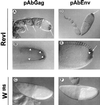
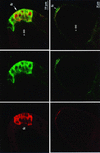

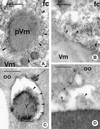
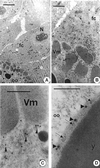
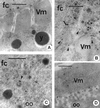
Similar articles
-
Infection of the germ line by retroviral particles produced in the follicle cells: a possible mechanism for the mobilization of the gypsy retroelement of Drosophila.Development. 1997 Jul;124(14):2789-98. doi: 10.1242/dev.124.14.2789. Development. 1997. PMID: 9226450
-
Invertebrate retroviruses: ZAM a new candidate in D.melanogaster.EMBO J. 1997 Dec 15;16(24):7521-31. doi: 10.1093/emboj/16.24.7521. EMBO J. 1997. PMID: 9405380 Free PMC article.
-
Viral particles of the endogenous retrovirus ZAM from Drosophila melanogaster use a pre-existing endosome/exosome pathway for transfer to the oocyte.Retrovirology. 2006 May 9;3:25. doi: 10.1186/1742-4690-3-25. Retrovirology. 2006. PMID: 16684341 Free PMC article.
-
In between: gypsy in Drosophila melanogaster reveals new insights into endogenous retrovirus evolution.Viruses. 2014 Dec 9;6(12):4914-25. doi: 10.3390/v6124914. Viruses. 2014. PMID: 25502325 Free PMC article. Review.
-
Drosophila germline invasion by the endogenous retrovirus gypsy: involvement of the viral env gene.Insect Biochem Mol Biol. 2002 Oct;32(10):1249-56. doi: 10.1016/s0965-1748(02)00088-7. Insect Biochem Mol Biol. 2002. PMID: 12225916 Review.
Cited by
-
flam piRNA precursors channel from the nucleus to the cytoplasm in a temporally regulated manner along Drosophila oogenesis.Mob DNA. 2019 Jul 6;10:28. doi: 10.1186/s13100-019-0170-7. eCollection 2019. Mob DNA. 2019. PMID: 31312260 Free PMC article.
-
Evolutionary history of LTR-retrotransposons among 20 Drosophila species.Mob DNA. 2017 Apr 27;8:7. doi: 10.1186/s13100-017-0090-3. eCollection 2017. Mob DNA. 2017. PMID: 28465726 Free PMC article.
-
Reactivation of a somatic errantivirus and germline invasion in Drosophila ovaries.Nat Commun. 2023 Sep 29;14(1):6096. doi: 10.1038/s41467-023-41733-5. Nat Commun. 2023. PMID: 37773253 Free PMC article.
-
In Drosophila melanogaster the COM locus directs the somatic silencing of two retrotransposons through both Piwi-dependent and -independent pathways.PLoS One. 2008 Feb 6;3(2):e1526. doi: 10.1371/journal.pone.0001526. PLoS One. 2008. PMID: 18253480 Free PMC article.
-
Temporal and spatial niche partitioning in a retrotransposon community of the Drosophila melanogaster genome.Nucleic Acids Res. 2025 Jun 6;53(11):gkaf516. doi: 10.1093/nar/gkaf516. Nucleic Acids Res. 2025. PMID: 40503684 Free PMC article.
References
-
- Coffin J M, Hughes S H, Varmus H E. Retroviruses. Cold Spring Harbor, N.Y: Cold Spring Harbor Laboratory Press; 1997. - PubMed
-
- Desset S, Conte C, Dimitri P, Calco V, Dastugue B, Vaury C. Mobilization of two retroelements, ZAM and Idefix, in a novel unstable line of Drosophila melanogaster. Mol Biol Evol. 1999;16:54–66. - PubMed
Publication types
MeSH terms
Substances
LinkOut - more resources
Full Text Sources
Molecular Biology Databases

